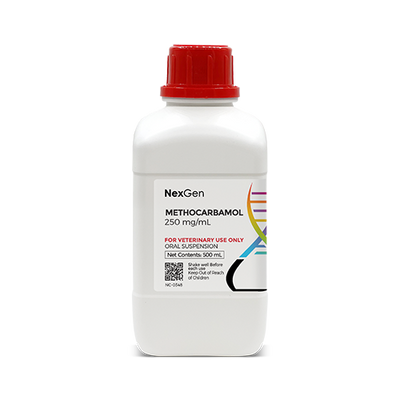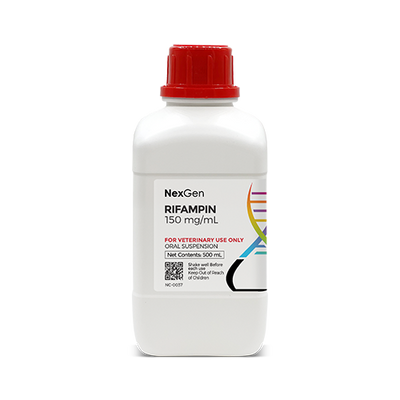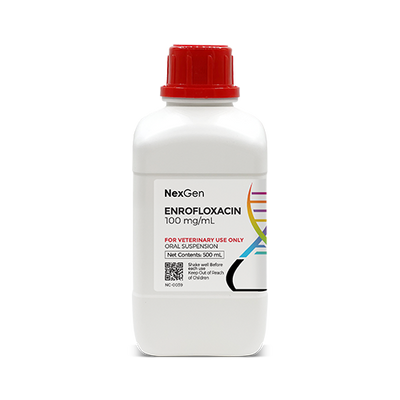
Misoprostol 240 mcg/mL, Oral Suspension, (500mL)
Login for pricing
- Brand
- Mixlab
- SKU:
- NC-0346
- Product Type:
- Suspension
- Size:
- 500ml
- Administration:
- Oral
Gastric ulcers are sores that form in the stomach lining. They are common in horses and have a prevalence estimated at between 50% and 90%. Ulcers can affect any horse at any age but occur most frequently in horses that are involved in athletic activities such as racing. This is due to the fact that exercise increases gastric acid production and decreases blood flow to the GI tract. The condition is officially recognized as encompassing two categories—equine glandular gastric disease (EGGD) and equine squamous gastric disease (ESGD).1
The horse’s stomach is divided into two discrete regions:
- The esophageal or non-glandular region
- The glandular region
The esophageal region (squamous mucosa) covers approximately 1/3 of the horse’s stomach, is devoid of glands, and is covered by stratified squamous epithelium similar to the esophagus. The glandular region covers the remaining two-thirds of the stomach and contains glands that secrete hydrochloric acid, pepsin, bicarbonate and mucus. A sharp demarcation (margo plicatus or cuticular ridge) separates the squamous mucosa from the glandular mucosa.2 When horses exercise, the acidic fluid in the stomach splashes and exposes the upper portion of the stomach to an acidic pH.
Gastric Ulcerative Disease in Horses
The horse’s stomach continuously secretes hydrochloric acid, and this occurs with or without the presence of feed. Foals secrete gastric acid as early as two days of age, and acidity of the gastric fluid is quite high, which may predispose foals to equine squamous gastric disease. ESGD affects the upper squamous region of the horse’s stomach, which is unprotected from gastric acid.
Equine glandular gastric disease involves the stomach’s lower region. Its prevalence depends on the horse’s breed and lifestyle, but the literature suggests ranges from about 10% to 65%. Incidence of ESGD is higher among Warmbloods and sport horses, at around 46% to 65%. In preliminary findings from one study, exercise frequency and performance level were associated with an increased risk of EGGD in show jumping Warmbloods, while feeding and exercise factors seem to contribute to increased risk of EGGD in Thoroughbred racehorses.2
Treatment of Gastric Ulcerative Disease in Equines
After confirming EGGD, omeprazole is usually the standard method of treatment. However, the literature holds that glandular disease tends to be more challenging to treat than the squamous variety. The reason for this is unknown, but diet and the duration of fasting prior to omeprazole administration may impact the drug’s pharmacokinetics and pharmacodynamics.2
Other pharmacologic effects of misoprostol include increased amplitude and frequency of uterine contractions, cervical thinning and relaxation, stimulation of uterine bleeding, and total or partial expulsion of uterine contents in pregnant animals.
Contraindications & Warnings
In horses, a study4 in midgestational pregnant mares given a 5-day course of oral misoprostol 5 µg/kg PO twice daily as a GI mucosal cytoprotectant during colic found that pregnancy was not disrupted and no adverse effects were noted.
The National Institute for Occupational Safety and Health (NIOSH) has classified misoprostol as a hazardous drug and recommends that personal protective equipment (PPE) be used to minimize the risk for exposure.
Where to buy Misoprostol
Misoprostol is available in the U.S. through pharmaceutical manufacturers and through veterinary custom compounding companies.
Please consult your veterinarian prior to beginning any treatment regimen.
FOR RX ONLY: A valid prescription from a licensed veterinarian is required for dispensing this medication.
1Haggett, E. Equine gastric ulcer syndrome in foals, UK-Vet Equine, 0.12968/ukve.2020.4.4.98, 4, 4, (98-101), (2020).
2Bezdekova, B., Wohlsein, P., Venner, M. Chronic severe pyloric lesions in horses: 47 cases, Equine Veterinary Journal, 10.1111/evj.13157, 52, 2, (200-204), (2019).
4Jacobson CC, Sertich PL, McDonnell SM. Mid-gestation pregnancy is not disrupted by a 5-day gastrointestinal mucosal cytoprotectant oral regimen of misoprostol. Equine Veterinary Journal. 2013;45(1):91-93.
5Rath W, Tsikouras P. Misoprostol for Labour Induction after Previous Caesarean Section - Forever a "No Go"?. Geburtshilfe Frauenheilkd. 2015;75(11):1140-1147. doi:10.1055/s-0035-1558171.


















